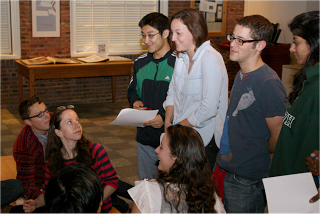- Public Policy
- Leadership
- Funding
- News & Events
- About the Center
Back to Top Nav
Back to Top Nav
Back to Top Nav
Back to Top Nav
Read a student's account of our most recent session in our Management Leadership and Development program below. For more information, about MLDP, click here.

When I got to this session, I didn’t know much about negotiation as a science. Sure, I haggled at flea markets and watched TV dramas that had two people stare at each other intensely across a table, but it’s something that I never put much thought into. It turns out that negotiation is far more than just shopping or shady business dealings; it stretches to decisions that are as mundane as deciding which movie to watch in a group and choices that mean life and death. In his presentation to the MLDP group hosted by the Rockefeller Center, John Garvey gave a talk and led exercises to teach us about the art of negotiation. Mr. Garvey defined negotiation by borrowing from William Ury’s book The Power of a Positive NO: “…negotiation is the process of back-and-forth communication aimed at reaching agreement with others when some of your interest and are shared and some are opposed." This is a thoughtful proposition: negotiation has to be between at least two people who have reason to compromise.
This idea of interest is quite appealing; as an expected government and economics major, I have heard self-interest bandied around nation-states and utility-maximizing decisions. To see it applied to interactions I have with people brought it home. For instance, during the first exercise, we worked in pairs, where one person (“A”) was freely given a hypothetical $10,000 and then tasked to decide how much of the $10,000 he or she was willing to share to the other partner (“B”). “B” then had the option of accepting or declining; if he or she declines, then no one gets the money. The roles were then reversed for the second half of the exercise. This lead to interesting issues, where some people accepted miniscule numbers of money and some people declined thousands because they felt it wasn’t fair. One person willingly gave more than half to his partner in order to buy goodwill. But this leads to the next question: since this is only a proposition, how can actual human behavior be modeled when real money is at stake? Well, it turns out that Mr. Garvey conducted this experiment with $20 given to each pair, and negotiations blow up for the same reasons as described: people had issues with fairness, generosity, and selfishness.
Next, we participated in “the NASA decision making exercise”, designed by the American Arbitration Association’s Department of Education and Training. It is an important exercise that determines the trade-offs and consensus-building that occurs during a life-and-death survival negotiation. The scenario is that our spaceship crash-landed in the moon, and our crew is divided into two groups, A and B. We have to work together to reach the rendezvous point or else everybody perishes. In the first phase of the simulation, we work individually by ranking fifteen items in order of their importance to survival. Then, we work with only within our respective group, either A or B, and we rank which of 15 items we prioritize the most. Both A and B has to decide which one is going to the RV point and which one is staying, and each group separately decides which items they value the most for the their respective mission. Then, in the last phase of the exercise, both groups meet and bargain which of the items that each group can receive. My group decided to dig in, and when we joined with our other half, we bargained using the principles to determine that the other group was more crucial to both of our survival because it had to find the spaceship.
I have not heard much about negotiations, even though in hindsight, it informs much of our daily lives. When you’re in a group of friends walking around and deciding the next course of action, such as watching a movie, there has to be consensus that comes from interest-based negotiations. When you’re forced to choose an option in intense bargaining, Mr. Garvey offered a rule of thumb: choose an option that leaves the most choice available later on. Lastly, decide whether it is interest-based or zero-sum negotiation.
- Edwin Yung ’15